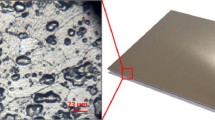Abstract
In this study, the effect of stacking sequence on the impact behavior of fiber metal laminates under the drop weight impact test was investigated. Four groups of specimens with layups of [Al-(0/90)8-Al], [Al-(±45)8-Al], [Al-(0/90)4-(±45)4-Al] and [Al-(±45)4-(0/90)4-Al] were fabricated and tested. Fiberglass–aluminum composite specimens were made of Al 2024-O sheets and woven glass fabrics with epoxy resin. These specimens were tested using a drop weight impact testing machine with an energy of 44.13 J and speed of 3.43 m/s. The results obtained showed a higher load-bearing capacity before failure of the outer aluminum layer for specimens with [Al-(±45)8-Al] layups. Fiber metal laminates with [Al-(0/90)8-Al], [Al-(0/90)4-(±45)4-Al] and [Al-(±45)4-(0/90)4-Al] layups had lower load-bearing capacities than the first group of specimens, respectively. The form of damage progression in the second layer of aluminum of specimens was completely dependent on the stacking sequence of composite layers. Numerical modeling of the drop weight impact test was carried out using ABAQUS 6.9 software. A detailed analysis of the failure mechanisms in the aluminum layer has been presented. A comparison between experimental results and the numerical simulation was performed to verify the simulation procedure.











Similar content being viewed by others

References
Vogelesang LB, Vlot A (2000) Development of fibre metal laminates for advanced aerospace structures. J Mater Process Technol 103:1–5
Krishnakumar S (1994) Fiber metal laminates—the synthesis of metals and composites. Mater Manuf Process 9:295–354
Reyes VG, Cantwell WJ (2000) The mechanical properties of fibre-metal laminates based on glass fibre reinforced polypropylene. Compos Sci Technol 60:1085–1094
Vlot A, Fredell RS (1993) Impact damage resistance and damage tolerance of fibre metal laminates. Proc 9th Inter Conf Compos Mater (ICCM/9), Composite Properties and Applications. 6:51–58
Vlot A, Kroon E, Rocca GL (1997) Impact response of fiber metal laminates. Key Eng Mat 141:235–276
Abdullah MR, Cantwell WJ (2006) The impact resistance of polypropylene-based fibre–metal laminates. Compos Sci Technol 66:1682–1693
Seyed Yaghoubi A, Liu Y, Liaw B (2011) Low velocity impact on GLARE 5 fiber-metal laminates: influences of specimen thickness and impactor mass. J Aerosp Eng 25:409–420
Wu G, Yang JM (2005) The mechanical behavior of GLARE laminates for aircraft structures. JOM 57:72–79
Carrillo JG, Cantwell WJ (2007) Scaling effects in the tensile behavior of fiber-metal laminates. Compos Sci Technol 67:1684–1693
Fan J, Guan ZW, Cantwell WJ (2011) Numerical modeling of perforation failure in fibre metal laminates subjected to low velocity impact loading. Compos Struct 93:2430–2436
Guan ZW, Cantwell WJ, Abdullah R (2009) Numerical modeling of the impact response of fiber-metal laminates. Polym Composite 30:603–611
Abdullah R, Cantwell WJ (2006) The impact resistance of fiber-metal laminates based on glass fiber reinforced polypropylene. Polym Compos 27:700–708
Seyed Yaghoubi A, Liaw B (2013) Effect of lay-up orientation on ballistic impact behaviors of GLARE 5 FML beams. Int J Impact Eng 54:138–148
Esfahani JM, Esfandeh M, Sabet AR (2012) High-velocity impact behavior of glass fiber-reinforced polyester filled with nanoclay. J Appl Polym Sci 125:583–591
ABAQUS (2003) ABAQUS, Theory Manual, Version 6.4. Hibbitt, Karlsson and Sorensen Inc., Rhode-Island, USA
ABAQUS (2003) ABAQUS/Explicit, User’s Manual, Version 6.4. Hibbitt, Karlsson and Sorensen Inc., Rhode-Island, USA
Kamat SV, Hirth JP, Mehrabian R (1989) Mechanical properties of particulate-reinforced aluminum-matrix composites. Acta Metall 37:2395–2402
Hashin Z (1980) Fatigue failure criteria for unidirectional fiber composites. J Appl Mech 48:846–852
Author information
Authors and Affiliations
Corresponding author
Rights and permissions
About this article
Cite this article
Taheri-Behrooz, F., Shokrieh, M.M. & Yahyapour, I. Effect of stacking sequence on failure mode of fiber metal laminates under low-velocity impact. Iran Polym J 23, 147–152 (2014). https://doi.org/10.1007/s13726-013-0210-y
Received:
Accepted:
Published:
Issue Date:
DOI: https://doi.org/10.1007/s13726-013-0210-y


